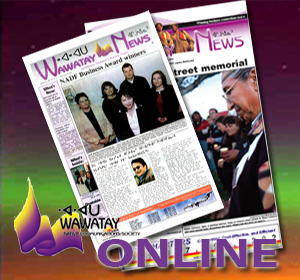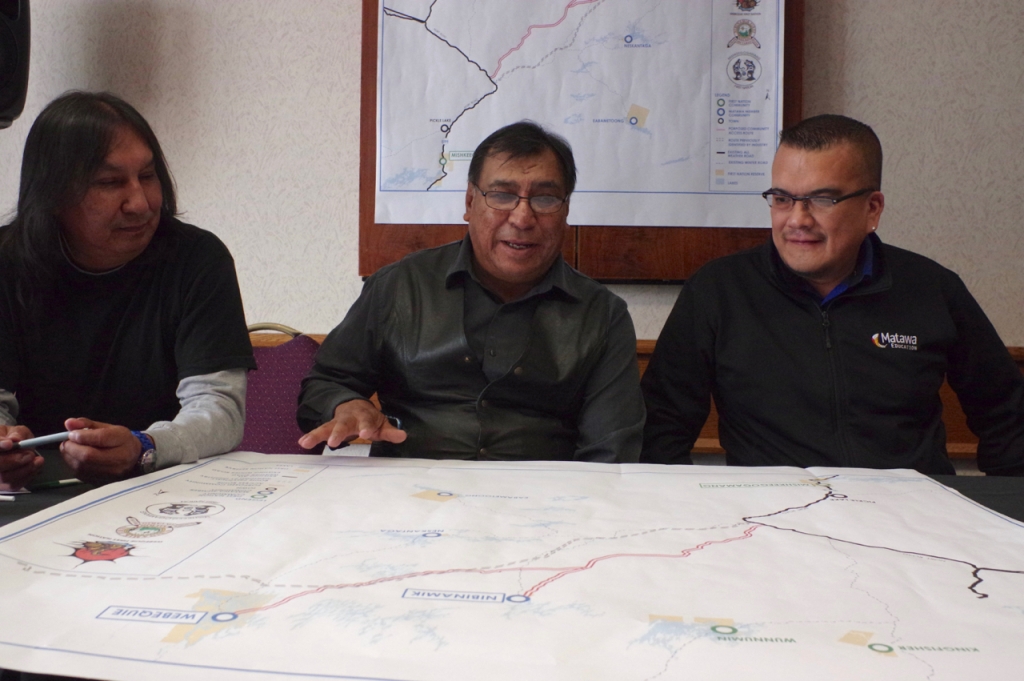Mishkeegogamang Chief David Masakeyash, Webequie Chief Cornelius Wabasse and Nibinamik Chief Johnny Yellowhead speak about the Nibinamik and Webequie study for a multi-purpose corridor during an Aug. 25 press conference in Thunder Bay. Photo by Rick Garrick.
The chiefs of Webequie and Nibinamik held a press conference on Aug. 25 to stress that they are only working on the continuation of a previous road option study that was completed last year. The study includes visual inspections of water crossings, traditional sites and environmental sensitive areas and does not include any mechanized activities.
“Webequie and Nibinamik First Nations are collaborating together on creating a plan to improve infrastructure between the two First Nation communities,” says Nibinamik Chief Johnny Yellowhead. “The Joint (Community Access) Infrastructure Planning Agreement is an agreement between Nibinamik First Nation and Webequie First Nation to first collaborate on the creation of a road study. How we got to this point is we created a working group to address infrastructure needs of the community, region and its people.”
The feasibility study is designed to narrow the proposed 10-kilometre wide conceptual routes to a two-kilometre wide route as well as to determine any environmental constraints and future environmental considerations. The corridor extends from the provincial highway near Pickle Lake to the two communities.
“Nibinamik First Nation is also working with Ryerson University from Toronto on the collection and protection of needs assessment study that addresses infrastructure and all-season roads access, with input from the community membership,” Yellowhead says. “And I would like to address to our neighbouring communities that Nibinamik First Nation has been committed to maintain environmental stewardship and protection of traditional lands with input from its members being necessary to the creation of any future development or infrastructure planning or projects.”
Yellowhead says the study does not affect or diminish Nibinamik’s commitment to the Regional Framework Agreement with the other Matawa First Nations communities.
“Nibinamik First Nation remains committed to working with its members and neighbouring communities to improve the lives of its people and future generations, building capacity and providing opportunities while maintaining our culture and language and our lands,” Yellowhead says. “We are still committed to working with our nine Matawa communities.”
Yellowhead and Webequie Chief Cornelius Wabasse held the press conference to emphasize the two communities’ commitment to working with the other Matawa communities after Ontario Premier Kathleen Wynne announced on Aug. 21 that the province is working with Webequie, Nibinamik and Marten Falls to plan and construct a year-round access road into Noront Resources Ltd.’s proposed mining development site in the Ring of Fire mineral development area and to build all-season access roads to the three communities.
“I am grateful to the Matawa First Nations, who have been working with us for years to get to this historic day,” Wynne says. “The entire Ring of Fire region has huge potential for development that would benefit all of the communities involved and the entire province — creating new jobs and improving the quality of life for people in the north. Getting shovels in the ground to build this connection to the Ring of Fire will move us forward towards unlocking its full potential.”
Wabasse says his community is located “in close proximity” to the Ring of Fire.
“So we are very concerned about the potential development in our area, but we have established a working relationship with Nibinamik in doing the study to connect the two communities and also to find ways that we can work together in moving forward on the beginning stages of potentially doing development in our area,” Wabasse says. “Webequie First Nation has always said that we are not opposed to development, we just need proper processes and protocols to be in place before we allow major development in our area.”
Wabasse says his community is “very committed” to working with the surrounding Matawa communities.
“We are very cognizant of the impacts that (we) will potentially have with our environment,” Wabasse says. “We continue to work together and we continue to make sure that we are transparent in what we do.”
Mishkeegogamang Chief David Masakeyash also spoke about his community’s support for the multi-purpose corridor study during the press conference, which was held at the Valhalla Inn in Thunder Bay.
“Mishkeegogamang sits at the westerly entrance of this proposed corridor,” Masakeyash says. “We are here to bring support for this initiative.”













As we are ready to honour November 11, Remembrance Day I think about the destruction war has done to my James Bay Cree family and my partner Mike’s Irish...
Gold has arrived. Here in the north of Ontario we see vast streams of gold shimmering across the landscape as autumn is here and the the leaves are turning...